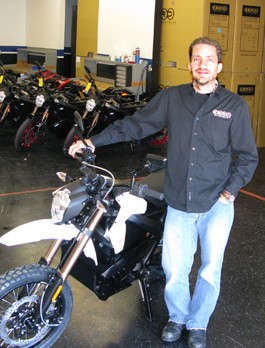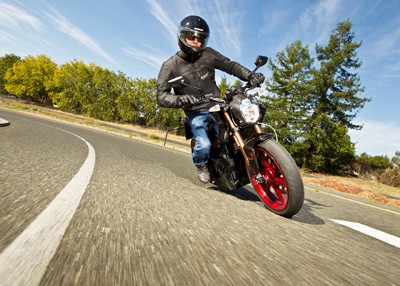Building green performance motorcycles

NEED FOR SPEED: Abe Askenazi leads the engineering team at Zero Motorcycles. (Photo by Daniel McGlynn.)
Harleys are throaty. Ducatis purr. Other motorcycles have their own signature sounds and vibration patterns. But most of the things motorcycle makers call character are really just covering up byproducts of internal combustion—and masking the energy lost during power production.
Electric motorcycles, on the other hand, are quiet, and from a power perspective more efficient. Both traits are not lost on the rider. “If you get on these electric motorcycles the first thing you notice is a magic carpet ride feel,” says Abe Askenazi, B.S.’92, M.S.’94 ME. “It’s almost like flying. It feels like you are on a glider and this thing is propelling you forward. You don’t hear all of the drama of power production, you are just doing it.”
Askenazi has traveled a long road to become the chief technology officer at Zero Motorcycles, one of the nation’s leading electric motorcycle manufacturers. He started tinkering with his first motorcycle as a kid growing up in Mexico City. By the time he was in high school and had moved to California with his mother, he was working with electronics.
At Berkeley, he started in the electrical engineering program, but missed taking things apart and putting them back together. So he switched over to mechanical engineering, bought a Harley, and started studying with Professor Albert Pisano. Pisano’s research focus is microelectrical mechanical systems, but Askenazi says, “He’s also a gearhead, so I convinced him to take me on to do this motorcycle thesis work I wanted to do.”
Originally, Askenazi set out to investigate alternative suspension architectures for motorcycles using existing mathematical models. However, he soon discovered that all published models were Lagrangian (energy-based) and their core assumptions rendered them invalid for the type of work he had set out to do. So he switched his project focus. By the time he completed his master’s in mechanical engineering in 1994, Askenazi had created a Newtonian (force-based) mathematical model for single-track vehicle dynamics.
During his first year of graduate school, Askenazi wrote to the Wisconsin-based motorcycle designer, Erik Buell, to explain his thesis and express his interest in a future job. He didn’t hear anything back. When he graduated he tried again, and eventually got a call and a job offer from Buell himself. So Askenazi moved to Wisconsin, and for the next 15 years he worked his way up the ladder until he was eventually senior director of analysis, test and engineering process. But in 2009, when the economy took a nosedive, so did motorcycle sales. Buell Motorcycle Company, at the time a subsidiary of Harley Davidson, was closed.
In 2010, when Askenazi got a call from a new motorcycle start–up back in California, he was interested. The company, Zero Motorcycles, wanted to build electric motorcycles, and they needed a head of engineering.

MAGIC CARPET RIDE: Cornering on a 2012 Zero S motorcycle. (Photo by ZERO MOTORCYCLES.)
“It seemed like a good fit,” Askenazi says. “Even during my time at Berkeley, another side passion of mine was environmentalism.” Currently electric motorcycles reduce overall emissions by 90 percent. That number will likely improve. “As the grid gets cleaner, electric vehicle emissions will get cleaner,” Askenazi says.
Electrifying performance motorcycles is not without its challenges. Sitting in his office outside of Santa Cruz, wearing leather motorcycle boots and a light beard, Askenazi explains how getting an electric motorcycle to go 100 miles on a single charge, which Zero has done with their 2012 models, was one of the first hurdles. “We went from about a 40-mile range to 110-mile range on the big bikes,” Askenazi says about city driving, “which is almost triple the range.” There are other challenges to overcome while building an industry, from distribution arrangements to charging infrastructure. All the while, the underlying technology, mainly battery chemistry and electric powertrain components, continues to evolve rapidly, like Moore’s Law for motorcycles, presenting design challenges and opportunities.
Electric motorcycles are cheap to operate—they cost on average about a penny a mile. And because they have a motor with one moving part and don’t need a clutch or transmission, there is little in the way of upkeep. “There’s no maintenance on our motorcycles’ powertrains,” says Askenazi. “There’s no oil to change, no tune-up to do, no valves to adjust, no air filter to swap. You don’t ever have to do anything to them, just plug them in and that’s it.”
So where does a world of no tune-ups or oil changes leave the kid who starts working on a motorcycle and ends up studying mechanical engineering? The way Askenazi sees it, the opportunities to tinker and build DIY–style bikes are increasing, not decreasing. And electrification projects require creativity and thought. He gives the example of a Zero intern who showed up for his interview on an electric motorcycle he built in his garage. “People are still tinkering,” Askenazi says. “People are tinkering quite a bit.”